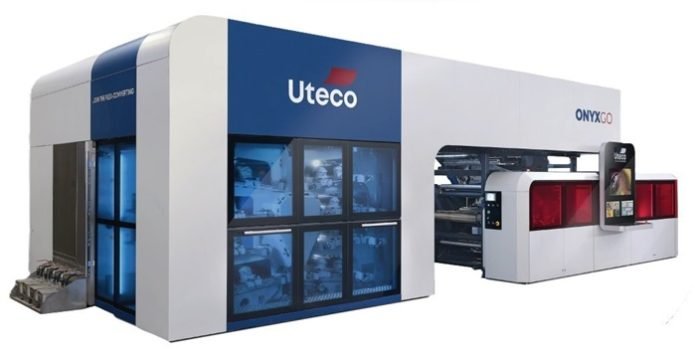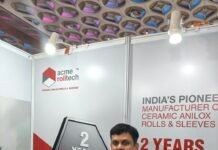While the various attributes, constraints, and strengths of the flexo and rotogravure processes or methods of print reproduction are evolving with innovations in consumables and automation, they continue to jockey for position as a favored technology in the flexible packaging industry as a whole. Each of these printing processes brings unique qualities to the table and, as technology advances, their roles in the market have undergone significant transformations.
Two recent seminars in Ahmedabad – the Flex-on-Road tour by Uteco, and the Game-changing Single-Pass Carton Production event by Eadale and DuPont, are a testament to flexography gaining in wider acceptance and market share in the industry. Both seminars mostly focused on the benefits of flexo printing, current packaging trends, and the perception of the organizers that the industry is shifting towards flexo printing due to its quality improvements and the increasingly higher demand for short-run flexible packaging materials.
With an engraved cylinder to transfer ink onto the substrate, rotogravure is renowned for its ability to reproduce images with extraordinary detail, high saturation, sharpness, and stability. This makes it the preferred choice for long-run work, where consistency and precision are paramount. Gravure’s dominance in the Indian flexible packaging industry, as in several Asian countries, is evident, especially where the demand for large quantities of high-quality print justified the initial setup and cylinder-making cost. (Although the use of hexavalent chromium is not yet banned in India, it is likely that brand owners, as they become more conscious, will ask Indian converters to comply with constraints on chrome vi similar to those being enacted in Europe for making gravure cylinders.)

“Rotogravure was overdominant. It was the entirety of the market while flexo was the new kid in town – but now flexo is gaining a significant chunk of the market share,” said Anan Hiyasat, IMEA region manager and MEA director for Uteco in an interaction with Packaging South Asia at the Ahmedabad flex-on-road.
Flexography with its enormous improvement in quality, especially in printing solids and its improved plate robustness, is bringing to bear its versatility of printing on a diverse range of substrates. Its quicker setups and makereadies, and its ability to economically produce the growing demand for short-run jobs, have created a space in the industry.
According to Hiyasat, the market shares of each technology are being sliced and in the future, there may not be a single dominant technology. Each method is focussing on a particular set of applications.
He admits that to date, there are many applications where flexo is not even close to the performance of rotogravure. “The fact is that flexo uses an anilox, which is a limitation. In certain varnishes, in metallic colors, which is very big in India for rice bags, nothing is better than rotogravure. If you want to print metallics in flexo it is crazily expensive and it’s just not worth the money. Whereas in roto, it is a normal print. Applications like hot seal, and cold seal will always be roto,” Hiyasat said.
Rutul Zaveri of the leading flexo plate trade-house Pinmark in Ahmedabad spoke about the recent and ongoing improvements in flexo prepress and platemaking. He showed us two similar samples produced using the two different printing techniques, which are hard to distinguish at the first look or examination. In our interaction, Zaveri defended the use of flexo for long-run jobs as well. “From the day flexo was introduced in the market, it has continually evolved so that it now supports the long-run jobs in the market. However, the long-run jobs are a dying market,” Zaveri said.
Hiyasat concurs that the reproduction quality of flexo has immensely improved, while 10 to 15 years ago, there was a huge gap between rotogravure and flexo printing. There were many limitations in terms of inks, plates, and even the presses. “Back then it was a huge effort to convince brand owners to move to flexo from gravure – they were convinced that flexo was worse. But now there is a change. For example, Lorven Flex and Sack India were the first converters in Hyderabad who moved from seven rotogravure lines to flexo.”
Co-existence in the market
Hiyasat forecasts the co-existence of rotogravure and flexo in the flexible packaging industry. It’s not about one process overshadowing the other, rather it’s about selecting the right tool for the job. Certain applications still warrant the precision and consistency offered by rotogravure. In situations where long-run jobs are concerned, rotogravure remains the preferred choice. On the flip side, the surge in demand for short-run jobs has given flexo a distinct advantage in that sphere. The ability to deliver quality print without the burden of excessive setup costs or the need for extensive inventory storage makes flexo the go-to choice for many businesses that need to control costs.
“Rotogravure is going to become more of a complementary line than your main production line because the only other advantage you have in roto is the long run and long runs are dying market,” according to Hiyasat. He anticipates a similar shift in the market dynamics related to machine manufacturing. As the industry adapts to the changing demands, he predicts a decrease in the number of manufacturers solely focused on rotogravure presses.
Uteco OnyxGo
Hiyasat highlighted the new Uteco OnyxGo CI flexo press at the Flex-on-Road event in Ahmedabad. It makes short runs for flexible packaging viable with low waste, energy, and solvent consumption. “Even though the flexible packaging market is growing, the runs are getting shorter and shorter. The inspiration for OnyxGo was from the surge of short-run jobs. However, there is no sacrifice, if you ever want long runs, it’s still a 400-meter-per-minute press.
While highlighting its event in Egypt this year as the most successful stop in the Flex-on-Road tour in 2023, he admitted India as the second most successful stop. “We are coming to India for the first time and it’s the biggest first-time event we have ever had. The upcoming year’s tour will be larger than this in India since word of mouth has its role to play.”











